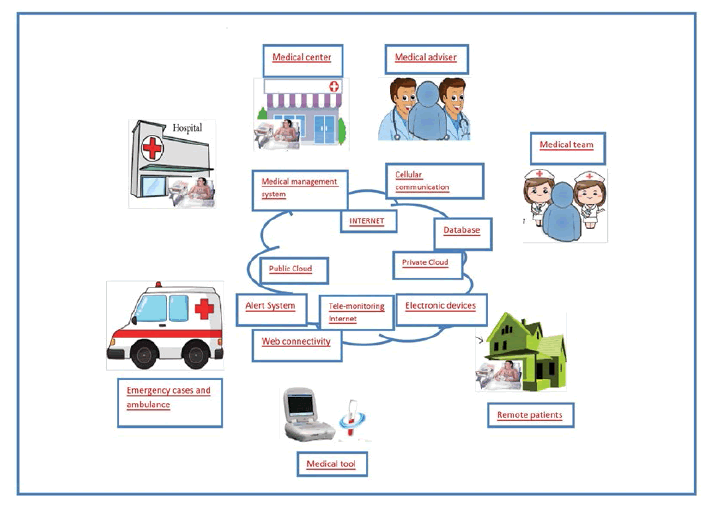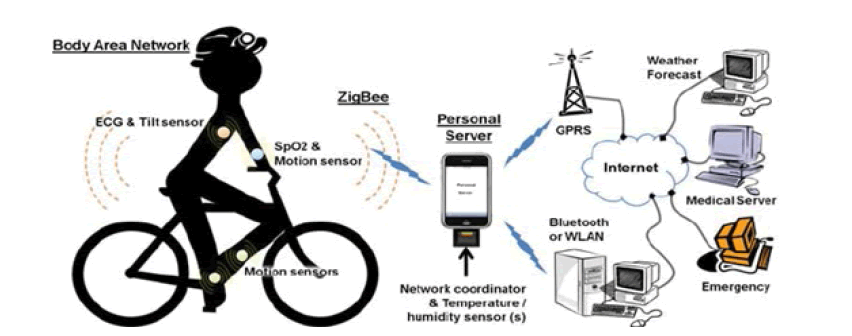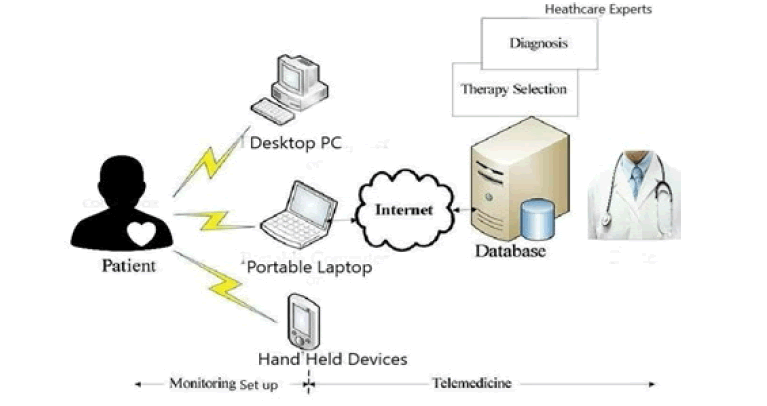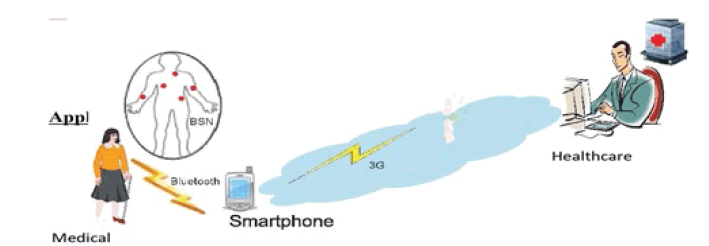Research - International Journal of Medical Research & Health Sciences ( 2022) Volume 11, Issue 4
An Overview on Cloud-Based Health Tracking and Monitoring System in Real-Time
Satish Polshettiwar1*, Ashwini Gawade1, Ashwin Kuchekar1, Akshay Baheti1, Manish Wani1, Jivika Naik1, Dnyanesh Limaye1 and Shankar Mali22Department of computer science Engineering, Dr. Vishwanath Karad MIT World Peace University, Pune, Maharashtra, India
Satish Polshettiwar, School of Pharmacy, Dr. Vishwanath Karad MIT World Peace University, Pune, Maharashtra, India, Email: drsatishpolshettiwar@gmail.com
Received: 26-Feb-2022, Manuscript No. ijmrhs-22-30322; Editor assigned: 01-Mar-2022, Pre QC No. ijmrhs-22-30322 (PQ); Reviewed: 20-Mar-2022, QC No. ijmrhs-22-30322 (Q); Revised: 15-Apr-2022, Manuscript No. ijmrhs-22-30322 (R); Published: 30-Apr-2022
Abstract
Today’s era could be known as the era of informatization. The advent of computers has built a solid foundation in traditional medicine. The growing trend is to create smarter health care that is all-inclusive and has multi-level flexibility different from the simple technical process. The transformation of the medical model has shifted from diseasefocused to patient-centered care and knowledge structure from clinical information to regional medical information. The collection and analysis of real-time data using innovative and enhanced facilities are very important for human health care. Modern communication technologies and smart systems enable patients to self-evaluate important signs from home and to advance the results of wireless communication to doctors. Such programs enable fixing the problem early before the patient needs intensive care. Cloud computing and health monitoring are integrated into Cloud-based healthcare consisting of a computer device and multiple sensors embedded in the patient’s body. Body vitals data such as heart rate and temperature are retrieved from a remote device with an advanced software program and stored in a central database through Internet, a computer device can deliver accurate medical information anytime, anywhere. This study provides statistics on the improvements made by private cloud computing modeling to monitor real-time medical data stored in an authorized region.
Keywords
Traditional medicine, Cloud computing, Real-time medical data
Introduction
Real-time health care monitoring empowers more and more rural people with rich health care. Such technology not only reduces the cost of living for rural people but also improves the quality of life and thus increases the living space of older people. Nerves are implanted in the body to collect body parameters information which triggers health changes. Prompt and immediate treatment is possible by diagnosing the problem at the infertility stage. More benefits can be made by more than sixty citizens to promote a healthy lifestyle. These technologies have enabled an improved lifestyle and resilience to healthy aging. The biggest challenge in the environment is to enter enough data for analysis. This method is to track the patient's call regularly for survival [1,2].
The goal is to develop a reliable, inexpensive, lightweight heart that is easy to wear with a wireless heartbeat and a warm sensor that is capable of transmitting data over a wire to handle a computer or health service robot. Apart from most programs, due to their limitations, a better efficient and intelligent system needs to be built.
In the healthcare sector, various devices and facilities are involved in monitoring patient health limits and can be improved as such.
Along with technology, health care systems also work. Health care works with human health where there are no risk factors due to the lack of health development equipment; that is why it is a critical science to deal with.
Most of the time medical staff is utilized in physical movement from patient to patient in the hospital for checking and updating patient’s health parameters like pulse rate, body temperature, oximetry, and blood sugar levels. Such a manual approach does not suit real-time health monitoring of patients, in particular, intensive care patients. In addition, the large number of patients who need simultaneous care poses a serious challenge and can lead to inaccurate information about the physical condition of all patients. Therefore, monitoring real-time health may prove to be beneficial in patient care.
Due to weakness, remote location, or lack of resources, a growing number of people are unable to seek medical help. In such cases, remote monitoring systems as a possible option may be helpful. Such timely treatment may be provided to patients, by actively monitoring the patient's condition and providing information to patients and medical professionals about any disorder before the emergence of an emergency. Most e-healthcare devices are built by. Various designs and techniques are incorporated into public health facilities to develop e-healthcare devices.
Automatic medical analytical tools are also available in clinical data, such as electrocardiogram analysts, who analyze in real-time and are counted as part of a remote monitoring system [3-5].
Since remote monitoring systems are not the latest technical solutions for patient health monitoring, many medical health systems have been organized for monitoring the health status of patients indoors as well as remote outdoor to tackle emergencies and to detect and treat health criticalities before they worsen. As telephone surveillance systems are relatively new to the latest technological solutions to patient health monitoring, several health programs are designed to monitor the state of health of patients at home and away to overcome urgent cases and to combat serious illnesses before they become serious (Figure 1).
To measure the medical data collected such as blood sugar, BP, heart rate/pulse rate, etc., medical signals, ubiquitous devices, or medical health sensors are connected to specific parts of patients' bodies and health information obtained will be transmitted wirelessly to the health care provider using a mobile network for further diagnosis using available medical information (Figure 2) [6-8].
Automated medical analysis tools such as ECG analysts can be used for real-time analysis of health data and be part of a remote monitoring system. Technologies like cloud-based systems are the best and most fearless solutions for existing networks to enrich them continuously. In terms of data monitoring, access, and storage, cloud computing tools play a major role in health care. The full functionality of health care systems is efficient and easily managed using and using community cloud computing technology in health care.
This means that the hospital can simply provide cloud computing services to support ongoing health care. They can also perform management and other data management requirements that can be accessed as real-time information for patients who avoid delays to accurately sync and share security between systems (and users). If there is a workload, the information can be retained where it is needed [9,10].
Cloud computing has an efficient public cloud for data monitoring and management of health care services worldwide and is considered appropriate in terms of security and expansion. The deployment of a mobile health care system involves a complex process that includes the needs of wireless and mobile networks such as reliable remote control, secure data storage, data exchange, confidentiality, continuous monitoring, effective mobility, and emergency medical care of patients.
Literature Review
The available technologies are provided below that support various aspects and functions of mobile health care.
Telemedicine System
Theoretically, telemedicine is a long-term consultation between two or more physicians to provide their patients with the best possible health care. Advances in telemedicine have been particularly evident in the last decade of the twentieth century with numerous studies attempting to use a variety of communication and computer technology to solve various medical issues. Modems are introduced in the program to allow the transmission of medical information through telephone cables. Initially, electrocardiograph data and other related medical devices, called telemetric units, were transmitted, moving slowly through image transfer. The rapid and rapid switching of telephone channels has contributed to the use of medical business video conferences and the development of various medical information processing systems. Email and Internet usage have begun (Figure 3).
Disadvantages: Since the seeing physician does not have the opportunity to meet the patient in person then no interaction contact with the patient becomes a major problem [11,12].
Pervasive Healthcare Systems
Extensive health care is a continuous process of research focused on the development and implementation of comprehensive (universal) technology for the health and well-being of patients. Important health parameters like BP, Temperature are recorded automatically by Bio-sensors attached to the patient's body as the physician approaches you. Such programs are called the Pervasive Healthcare System (Figure 4).
Disadvantages: It consumes huge power. The application is costly and complex.
Application
• A fully functional system does not require human intervention. The departure of the affected person is provided as an automatic warning
• Remote monitoring of patient health limits is possible
• This project can be used for patients or sick persons or elderly persons at home
• It is also used in hospitals and health centers
• Hospital care is expensive and disruptive so patients who need ongoing care also prefer the comfort of being at home. Accurate and timely health information can be provided to health professionals through complex home health care
• By providing continuous feedback on changes in the well-being of patients receiving treatment, an intelligent monitoring system will be able to monitor patients’ progress in real-time [13,14]
Different Projects
Research into this field has grown exponentially with the aging of the urban population. To integrate this sector of people, modernized communication is required between citizens and the city. To address this, many projects with a variety of solutions have been developed, seeking to expand assisted living spaces that include outdoor and public spaces and not just the interior, aimed at producing a range of services that will advance the well-being of citizens. Such projects securely collect data from citizens and analyze it to create a general purpose or condition of an intervention-based program that may inform health care providers, caregivers, or administrative staff of potentially catastrophic flood events such as MCI or assisted mortality.
Smartphones and wristbands are used to collect user data through a program called Prevent IT to identify potential risks based on their behavior pattern [12]. Both internal and external user data are collected. Based on this data, the intervention plan assesses whether there is a health risk for the user and whether interference from outside agencies such as medical doctors or caregivers is required. The system is amazing at allowing such intervention solutions to be implemented throughout the city.
Medical and technical goals are combined to create a complete system with Frail Safe [13]. This program understands the illness of the elderly to deal with the consequences of the future and is designed with tools that can help the elderly. It also creates recommendations to prevent future accidents.
Various data sources such as motion sensors, smartphones, or GPS systems are used to collect internal and external personal data of all users in this application; which in turn is used for the intervention plan to improve with greater accuracy.
A large amount of information is not available in the design of the system, so it cannot be used in the broader context of the city, instead of focusing more on the individual monitoring and intervention system.
To ensure safe and healthy aging, the Net Store project aims to create a multi-skilled, multi-functional, customized training framework [14]. The machine helps the elderly. ICT-based technology is used to collect data from external as well as internal places and is likely to include all city dwellers in the context of the entire city. This project creates a personalized trainer based on the information obtained, providing tips for improving human well-being.
In the domestic space, AGNES user data is collected by ICT-based solutions [15]. The main idea of this approach is to promote the elderly and facilitate a healthy lifestyle by building a web-based social network. This web-based framework contains data about the health parameters of viewed users and this information is displayed to family and friends or informal health care providers in easy-to-interpret language. Remote access is possible by sharing information collected on the web but does not collect data from the outside. Such constructions that focus on internal data only do not give you the complexity and cannot be applied to the context of the whole city.
STIMIMATE is another popular ICT tool that collects information for seniors and recommends the best way to travel around the city based on the right thinking of their skills and physical condition [16]. People can plan their trips using a cell phone in this framework. This program focuses exclusively on external spaces and data from internal spaces cannot be collected. The system can be applied to the context of an entire city as the project is used by only a few.
The concept of “smart wall” is used by the e-WALL project [17]. A feature of this wall is to provide real-time abnormal information about the alert user's health status and clinical measures such as neuromuscular and cardiopulmonary status. It encourages older citizens to live independently as their health status information in the indoor environment can be collected. This project is limited to internal data collection space; however, in the context of the whole city, it can be questioned. It does not collect external data; therefore, it cannot consider any condition or measure any performance when these older users perform outdoor activities.
USEFIL and the inCASA project are similar [18,19]. The inCASA project uses an ICT platform that integrates Telehealth and Telecare. USEFIL uses open-source solutions as IoT-based solutions for data collection for older people in home spaces. The data collected is further collected to create a custom profile that generates user alerts to improve health and promote independent health. The focus is on data collection in internal space and not external space. In addition, the construction of the project does not allow for a downturn in the context of the entire city.
CARE monitors and collects data from indoor spaces and generates automatic alarms. In case of potential health risk situations detected by the system, the alarms are used eg. fall or health hazard. This project enables a smart environment for finding critical situations in the case of elderly users. This function only uses default technology, so it is not designed to collect data from smartphones, smartphones, or any other type of device that can record data to the user when it is not in an extended location. The project is likely to be easily implemented in the context of the entire city but is limited to indoor spaces.
Businesses discussed so far do not share information in the form of an open Datalink, providing a clear explanation for all data collected and processed to allow access to third parties. This information can be an invaluable source of information for developing current programs or creating new ones. The following projects use the Linked Open Data method.
Smart Santander is a city-wide project. The project seeks to improve the well-being of Santander residents by unobtrusively collecting data. The project collects data from citizens in internal and external spaces through a variety of ICTs solutions, such as motion sensors, NFCs, GPS, or QR codes. In addition, the project contains a module that can convert the obtained data into semantic data that will be shared with third parties and try to develop new solutions that can improve the lives of Santander citizens.
The Smart Odense project is an initiative of the Odense Municipality and the University of Southern Denmark to improve the lives of Odense citizens. This function sends various sensors to the city to monitor the activities of the citizen, for example when a citizen uses the bicycle service the sensors will record its use in real-time and will inform potential users about where they are for free on bikes. In addition, the project tracks high-risk residents to know if they need to intervene and control the signals they receive if they are at risk of eviction. This project contains similarities to Smart Santander but only collects data from external sources.
The ACTIVAGE project provides an open framework for providing critical interoperability of active and healthy IoT platforms. The project provides a collection of various layers based on IoT solutions to collect data from citizens and share it with third parties using Linked Open Data. The main idea of the project is to create a smart environment to reduce poor living conditions and maintain the quality of life of citizens by providing them with an independent system [16-19].
Conclusion
In the present review, we have done an extensive literature study for a wireless sensor device to monitor some of the most important signs of health and to communicate with a remote computer or service robot. With this modern communication technology and smart systems, patients will be able to process their home health symptoms and send results to their wireless healthcare providers. In addition, through the use of cloud computing infrastructure, the health organization can manage the structure of the entire organization, as the solution emerges with an integrated healthcare system. This study sets out the design and development of an inexpensive and reliable sensor for collecting important real-time signals such as a person's body temperature and heart rate.
Declarations
Conflict of Interest
The author(s) declared no potential conflicts of interest with respect to the research, authorship, and/or publication of this article.
References
- Singh, Kajal, Divya Sharma, and Shipra Aggarwal. "A real time patient monitoring system based on Artificial Neural Fuzzy Inference System (ANFIS)." International Journal of Computer Applications, Vol. 146, No. 15, 2016, pp. 22-28.
Google Scholar Crossref - Hall, Michael W., and Anne M. Jensen. "The role of pulse oximetry in chiropractic practice: A rationale for its use." Journal of Chiropractic Medicine, Vol. 11, No. 2, 2012, pp. 127-33.
Google Scholar Crossref - Conner, W. Steven, Lakshman Krishnamurthy, and Roy Want. "Making everyday life easier using dense sensor networks." International Conference on Ubiquitous Computing, Springer, Berlin, Heidelberg, 2001.
Google Scholar Crossref - Tolar, D., et al. "Wireless system for monitoring body temperature." 7th WACBE World Congress on Bioengineering 2015, Springer, Cham, 2015.
Google Scholar Crossref - Baker, Chris R., et al. "Wireless sensor networks for home health care." 21st International Conference on Advanced Information Networking and Applications Workshops (AINAW'07), Vol. 2, IEEE, 2007.
Google Scholar - Sherrill, D. M., et al. "Accelerometer-based measurement of exercise and mobility for pulmonary rehabilitation." IEEE 30th Annual Northeast Bioengineering Conference, 2004. Proceedings of the. IEEE, 2004.
Google Scholar - Lorincz, Konrad, et al. "Sensor networks for emergency response: Challenges and opportunities." IEEE Pervasive Computing, Vol. 3, No. 4, 2004, pp. 16-23.
Google Scholar - Lubrin, Einstein, Elaine Lawrence, and Karla Felix Navarro. "Wireless remote healthcare monitoring with motes." International Conference on Mobile Business (ICMB'05), IEEE, 2005.
Google Scholar - He, Dayu. "The zigbee wireless sensor network in medical care applications." 2010 International Conference on Computer, Mechatronics, Control and Electronic Engineering, Vol. 1, IEEE, 2010.
Google Scholar - Dishman, Eric. "Inventing wellness systems for aging in place." Computer, Vol. 37, No. 5, 2004, pp. 34-41.
Google Scholar - Jafari, Roozbeh, et al. "Wireless sensor networks for health monitoring." The Second Annual International Conference on Mobile and Ubiquitous Systems: Networking and Services, IEEE, 2005.
Google Scholar - Ding, Chengcheng, Xiaopei Wu, and Zhao Lv. "Design and implementation of the Zigbee-based body sensor network system." 2009 5th International Conference on Wireless Communications, Networking and Mobile Computing, IEEE, 2009.
Google Scholar - Wang, Ping. "The real-time monitoring system for in-patient based on zigbee." 2008 Second International Symposium on Intelligent Information Technology Application, Vol. 1, IEEE, 2008.
Google Scholar - Singh, Jigyasa. "Health monitoring system using mbed NXP LPC11U24." 2015.
- Kumar, Ranjith, and S. Prabu. "Smart healthcare monitoring system for rural area using IoT." International Journal of Pharmacy & Technology, Vol. 8, No. 4, 2016, pp. 21821-26.
Google Scholar - Parane, Khyamling A., et al. "Cloud based intelligent healthcare monitoring system." 2014 International Conference on Issues and Challenges in Intelligent Computing Techniques (ICICT), IEEE, 2014.
Google Scholar - Kshirsagar, Pravin, et al. "A review on IOT based health care monitoring system." ICCCE 2019, Springer, Singapore, 2020, pp. 95-100.
Google Scholar Crossref - Kim, Mucheol, Ka Lok Man, and Nurmamat Helil. "Advanced internet of things and big data Technology for Smart Human-Care Services." Journal of Sensors, Vol. 2019, 2019.
Google Scholar Crossref - Nagaraja, B. G., and H. S. Jayanna. "Real-Time healthcare monitoring system using locally made device." Austin Journal of Biosensors & Bioelectronics, Vol. 4, 2018, pp. 1-4.
Google Scholar




